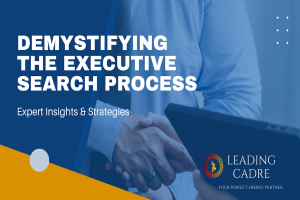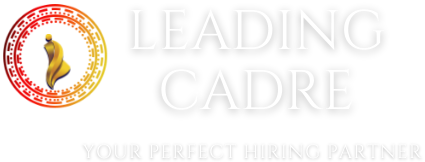In today’s competitive business landscape, the recruitment process plays a pivotal role in identifying and recruiting talent that fits seamlessly within an organization. Bringing in the perfect talent when it’s needed most has turned into a real game-changer for organizations. No doubt about it, the effect of picking the best-fit candidate is huge. It doesn’t just boost productivity and creativity but also spares organizations loads of valuable time, money, and hard work down the road.
According to a study by the Society for Human Resource Management (SHRM), companies with effective hiring strategies are 17% more productive and have a 35% higher revenue per employee. This statistic highlights the immense value of finding and onboarding the right talent for achieving organizational goals.
Time is undoubtedly a precious resource for businesses. According to the same SHRM study, it was found that on average, it takes around 42 days to fill a position. However, when organizations make a bad hiring decision, it can lead to an even lengthier process of correcting the mistake and finding a replacement. When businesses put their energy into getting the right people on board from the start, they can greatly cut down on the time spent on recruiting, training, and rehiring. This means they get to put more time into their big plans and fueling growth.
Furthermore, selecting the right talent leads to cost savings in various aspects of the business. A study conducted by the Chronicle of Higher Education found that the cost of a bad hire can be up to three times the individual’s annual salary.
More than just saving money, finding the right talent also saves organizations a bunch of valuable effort and resources. When employees fit their roles well, they need less hands-on guidance, stick around longer, and add a positive vibe to the team.

Your employer brand plays a vital role in attracting top talent & promotes employee engagement. Forgetting to put effort into creating a great employer brand can make it tough to shine in a job market full of competition.
The Impact of Employer Brands on Attracting Talent
- A strong employer brand attracts qualified candidates who align with your organization’s values and mission.
- Employer branding can significantly decrease time-to-hire and improve overall recruitment outcomes.
Strategies to Boost Employer Branding
- Develop a compelling employee value proposition that highlights unique benefits and opportunities.
- Leverage employee testimonials and positive reviews to showcase your company culture and reputation.
Make your Job offer magnetic—and deliver
Making your job offer magnetic and delivering on it is crucial for attracting and retaining top talent. When crafting a job offer or compiling a Job description, it’s essential to highlight the unique value proposition of the position and the company. Poorly defined job descriptions lead to confusion and mismatches between job requirements and candidate expectations. This flaw can slow down your hiring process and lead to hires that don’t quite fit, causing turnover. It’s super important to lay out the job duties, chances to grow, and the difference the candidate can make. Plus, don’t forget to highlight the special perks and goodies that make your organization stand out.
But it’s not as simple as just making the job offer sound cool. It’s just as crucial to actually follow through on the stuff you promised during the whole recruiting journey. Once a candidate accepts the offer after the interview process, ensure a smooth onboarding process and provide the necessary resources and support for them to succeed. Maintaining open lines of communication, fostering a positive work culture, and offering opportunities for growth and development will not only attract exceptional talent but also retain them for the long term. By making your job offer magnetic and following through on your commitments, you build trust, engagement, and a reputation as an employer of choice.
Diversify your Recruiting Strategies
Relying solely on traditional recruitment channels limits your access to a diverse talent pool. Trying out different ways to find talent can help you discover qualified individuals who might not fit the usual expectations.
Broadening the Search Horizons
- Explore industry-specific job boards, social media platforms, and professional networking sites to reach a wider audience.
- Establish relationships with educational institutions, industry associations, and community organizations to tap into emerging talent.
Leveraging Online Platforms for Talent Sourcing
- Utilize social networking platforms, such as LinkedIn and niche professional communities, to tap potential candidates.
- Leverage data-driven recruitment tools to identify and engage passive candidates who possess the desired skills and experiences.
Recruiting Fairly
Sometimes, without even realizing it, our biases can affect who we hire. This can end up causing unfair hiring results that keep inequalities going and make it harder to have a diverse team.
The Subtle Impact of Unconscious Bias on Hiring Decisions
- Stereotypes, affinity bias, and the halo effect can influence recruiters’ perceptions of candidates and lead to biased assessments.
- Biased practices hinder diversity by favoring certain backgrounds, experiences, or characteristics over others.
Strategies to Tackle Biases in Hiring and Dodge Bad Hires
- Establish structured interview processes with standardized evaluation criteria to minimize subjective judgments.
- Train recruiters and hiring managers how to spot and handle unconscious biases.
- Implement blind resume screening techniques to focus on qualifications rather than personal details.
Incorporate Relevant Assessments for Job Applicants.
Superficial evaluations during the hiring process can lead to not-so-great hires. Just depending on interviews can be like only looking at the tip of the iceberg, missing out on important stuff about what a candidate can do.
The Pitfalls of Superficial Evaluations
- Interviews alone may not provide an accurate reflection of an active candidate’s skills, work style, or cultural fit.
- Traditional assessments often lack the depth required to evaluate a candidate’s potential for growth and contribution.
Implementing Effective Candidate Assessment Methods
- Include practical assessments, case studies, or performance simulations to assess a candidate’s skills in action.
- Utilize behavioral assessments and personality tests to gain insights into compatibility with the role and team dynamics.
Resolving the Soft skills oversight
While technical qualifications are crucial, neglecting the importance of soft skills can hinder teamwork, communication, and overall organizational synergy.
Overlooking the Importance of Soft Skills
- Even if candidates are super skilled in the technical stuff, they might find it hard to work together, adjust to changes, or communicate effectively.
- A lack of soft skills can impede career progression and hinder an organization’s ability to thrive in a dynamic environment.
Incorporating Soft Skills Assessment into Recruitment
- Develop a framework to identify and assess soft skills relevant to each role.
- Utilize behavioral-based interview questions and reference checks a shot to see how good a candidate is at those soft skills.
Embracing Recruiting Software: Exploring the ATS Advantage
Employing recruiting software, such as an Applicant Tracking System (ATS), can significantly streamline the recruitment process. An ATS offers a centralized platform where organizations can manage job postings, track applicant data, and automate various stages of recruitment, from initial applications to final hiring decisions.
This technology not only enhances efficiency by reducing manual tasks like resume sorting but also improves collaboration among hiring teams. Thanks to cool stuff like automated communication, resume parsing, and tracking candidates, an ATS makes sure the whole recruiting process is smooth and tidy. It’s like having your back, letting HR folks concentrate on the important stuff. This helps speed up making choices about who to hire and makes the whole recruiting thing nicer for everyone involved.
Fostering Inclusion through Diversity
A diverse workforce including both male and female candidates is essential for innovation, creativity, and problem-solving. If you don’t make diversity and inclusion a priority, things might just stay the same within your team and this can lead to a lack of new ideas, perspectives, and experiences, which isn’t so great for the team’s growth and success. Plus, it’s just a way cooler and more interesting workplace when everyone brings their unique strengths to the table!
The Significance of Diversity in the Workplace
- Diverse perspectives foster innovation, leading to better decision-making and problem-solving.
- A diverse workforce better represents your customer base and enhances your brand’s reputation.
Establishing Inclusive Hiring Practices
- Craft job descriptions to promote inclusivity in your organization, making it obvious that your company values diversity.
- Go ahead and actively look for candidates from groups that aren’t represented as much. Also, try out ways to lower the chance of not-so-conscious biases when shortlisting talent.
Move as quickly and efficiently as possible in the Recruitment process
Prolonged recruitment processes can result in candidate drop-offs, missed opportunities, and decreased overall efficiency.
The Consequences of Prolonged Recruitment
- Exceptional candidates may accept offers from other companies during an extended evaluation period.
- When the interview process takes too long, good candidates that fit the bill might lose interest. This could mean fewer people in your candidate pool and the necessity to keep searching for talent.
Streamlining the Hiring Process
- Give each step of the hiring process a clear timeline so things run smoothly and quickly.
- Make the most of technology and automation, like applicant tracking systems aka ATS, to handle repetitive and time consuming tasks automatically and converse effectivity with talent
Leveraging Digital Trends and Social Media to attract, engage and retain Talent.
In the world of today’s digital age, the way technology and social media impact the hiring process is truly game-changing. Those digital trends and social media platforms? They’re like superhero tools that help organizations find and hire top talent. From employer branding to candidate sourcing, these platforms offer unique opportunities to bridge the gap between job seekers and employers.
Digital trends have revolutionized the recruitment landscape by streamlining processes and increasing efficiency. In the contemporary landscape, the advent of applicant tracking systems (ATS) has facilitated recruiters in effectively tracking and arranging candidate applications, monitoring progress, and seamlessly collaborating with hiring teams. Furthermore, the integration of automation tools has empowered recruiters to swiftly screen resumes, plan and schedule interviews, and send personalized and tailored communications in a fraction of time.
Meanwhile, social media platforms have become a breeding ground for connecting with potential candidates. LinkedIn, for instance, has evolved from a professional networking site to a bustling hub for job seekers and recruiters alike. Employers have the opportunity to showcase their organizational culture, values, and available job positions. Simultaneously, candidates can build professional profiles and interact with industry-focused content, resulting in a mutually beneficial association.
Attracting Top Talent: Investing in Benefits and Perks.
Offering quality employee benefits and perks is key to attracting and retaining top talent in today’s competitive job market. Gone are the days when a competitive salary alone would suffice to attract and arrest employee turnover. Companies now understand the importance of providing a comprehensive benefits package that goes beyond the basics.
Aspects such as health insurance, retirement plans, paid time off, and flexible work arrangements have become the norm and are expected by job seekers. In addition, employers are offering unique perks such as wellness programs, employee assistance programs, professional development opportunities, and work-life balance initiatives. These benefits and incentives not only elevate employee contentment and commitment but also play a role in boosting morale, productivity, and the holistic well-being of employees.
By offering high-quality employee benefits and incentives, organizations showcase their dedication to investing in their workforce and establishing an appealing, constructive work environment that distinguishes them from their competitors.
Run a Background Check and check References.
Running a background check and checking references once a candidate is selected for a role is a critical step in the hiring process. While resumes, interviews, and assessments provide valuable information, conducting due diligence through background checks and reference checks ensures that the selected candidate is a reliable and trustworthy fit for the position.
Background checks verify essential details such as employment history, education credentials, criminal records, and professional licenses, providing essential information about a candidate’s qualifications and integrity. Moreover, contacting references allows for firsthand insights into a candidate’s past performance, work ethic, and compatibility within a team. These verifications aid in minimizing potential risks, ensuring adherence to legal regulations, and protecting the reputation and interests of the organization. By incorporating thorough background checks and reference checks into the recruiting process, employers can make informed decisions and increase the chances of selecting the right candidate for the role.
Overcoming Post-Hire neglect
Conducting post-hire assessments is crucial for gauging the efficacy of your recruitment choices and optimizing long-term success within your organization.
The Importance of Post-Hiring Analysis
- Analyzing the performance and satisfaction of new hires helps identify and rectify potential flaws in the hiring process.
- Evaluation after hire allows for adjustments in onboarding and development programs to maximize job fit and employee retention.
Evaluating Job Fit and Onboarding Effectiveness
- Implement performance evaluations during the onboarding period to monitor progress and identify any skill gaps.
- Gather feedback from both the new hire and their team to gauge cultural fit and assess the effectiveness of the onboarding process
Conclusion
In conclusion, hiring the right talent at the right time is not only a key driver of productivity and revenue but also a significant factor in saving time, money, and effort. By proactively investing in effective hiring strategies and processes, organizations can ensure the right fit, reduce recruitment timelines, minimize costs, and maximize overall success.
FAQ’s
How does hiring the right talent impact an organization’s productivity? Hiring the right talent ensures that employees have the necessary skills and expertise to perform their roles effectively, resulting in increased productivity and improved overall performance.
What is the significance of cultural fit in the hiring process? Cultural fit signifies how well a candidate adopts or aligns with the company’s values, beliefs, and working style. Hiring individuals who fit the company culture fosters stronger teamwork, employee engagement, and overall organizational success.
In what ways can digital trends and social media platforms enhance the recruitment process? Digital trends and social media platforms offer avenues for bolstering employer branding, sourcing potential candidates, and refining recruitment procedures, thereby enabling organizations to establish more efficient connections with and draw in top-tier talent.
How do employee benefits and perks contribute to attracting and retaining talent? Offering comprehensive employee benefits and incentives, encompassing health insurance, retirement schemes, and flexible work options, showcases a dedication to the well-being, contentment, and work-life equilibrium of employees. This commitment enhances the appeal of organizations to prospective candidates and contributes to heightened employee retention rates.
Why are conducting background checks and reference checks necessary? Many Employers hire Background check companies for conducting background checks and checking references about a candidate’s qualifications, integrity, and past performance as mentioned in the candidate’s application form. These steps help organizations verify the accuracy of the information provided by the candidate and make informed decisions while mitigating potential risks.
How can hiring the wrong talent impact an organization financially? Hiring the wrong talent can result in increased turnover rates, decreased productivity, and additional costs associated with recruitment, training, and potential legal issues. The financial impact can be significant, potentially costing organizations up to three times the individual’s annual salary.
How can organizations improve their onboarding process? Organizations can enhance their onboarding process by implementing performance evaluations during the onboarding period, collecting feedback from new hires and their teams, and making necessary adjustments to ensure a smooth transition and maximize job fit.
What potential outcomes might arise from not selecting the perfect talent for a given position? A bad hire can lead to a decrease in productivity, team morale, and overall organizational success. It may result in frequent turnover, increased hiring costs, and a negative impact on the company’s reputation.
How can HR professionals optimize their hiring strategies? HR professionals can optimize their hiring process & strategies by using data-driven approaches, leveraging technology and automation tools, conducting thorough interviews and assessments, and continuously measuring and improving the effectiveness of their recruitment processes.
What are the key considerations when assessing a candidate’s qualifications? When assessing a candidate’s qualifications, key considerations include their relevant skills, experience, education, certifications, and achievements. It is important to align these qualifications with the requirements of the role and the overall goals of the organization.




